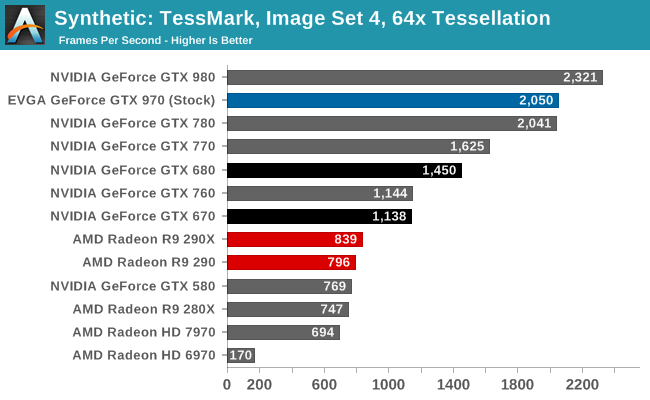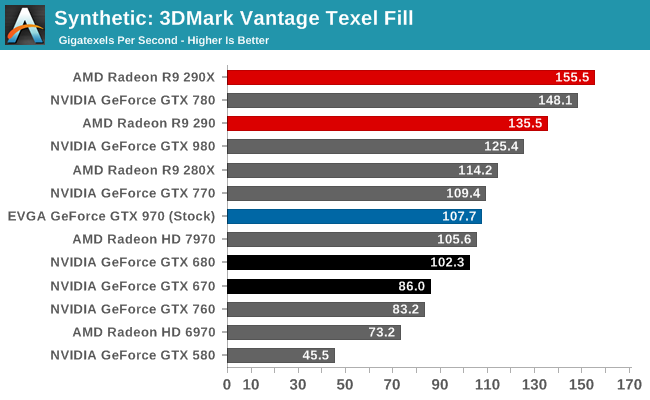The NVIDIA GeForce GTX 970 Review: Featuring EVGA
by Ryan Smith on September 26, 2014 10:00 AM ESTSynthetics
As always we’ll also take a quick look at synthetic performance. These tests mainly serve as a canary for finding important architectural and configuration changes.

Tessellation performance has scaled very closely with the change in SMMs and clock speeds, just as we would expect here.

Texel throughput has also taken a hit in accordance with the loss of SMMs and clock speed. Based on gaming performance the GTX 970 doesn’t appear to be too badly handicapped here, but it definitely doesn’t have much in the way of texel throughput to spare.

Pixel throughput on the other hand ends up being extremely odd and not at all what we were expecting. The GTX 970 takes an incredible dive here, with its pixel fillrate dropping by 26%. At a high level this test is bounded by memory bandwidth and ROP throughput, and both of these factors should be identical between GTX 980 and GTX 970. Instead we see GTX 970 lose more performance than should theoretically be possible, as the 26% drop is more than the accumulated difference between the clock speed and SMM differences.
At this point we’re still trying to figure out exactly what’s going on. We have no other evidence that there’s a difference in ROP throughput or memory bandwidth between the GTX 980 and GTX 970 so it is not clear to us where the difference lies. One possibility is that this is somehow bottlenecked at the Raster Engine level – where each of the four engines accounts for 25% of the work – but the pigeonhole principle means that NVIDIA can’t disable a GPC since at least 1 SMM must be active in each GPC partition. This matter will require further research.










155 Comments
View All Comments
vred - Friday, September 26, 2014 - link
Memory chips don't really need heatsinks, but memory VRMs do - so if overclocking memory, you have to watch their temperature and take care of their proper cooling.eanazag - Friday, September 26, 2014 - link
I am happy to see both Nvidia cards come out packing heat. for once Nvidia isn't totally price gouging at launch. In fact, we should see AMD prices come down soon as AMD reviews Nvidia's sales numbers. The 290 and 290X are pushing like 10 months on the clock at pretty much launch prices. it is about time we the price have a reason to come down. The 970 is the card to do so.Assumedly, Nvidia already has the 980 TI taped out for AMDs next response card. I am disappointed to see that there is no builtin audio decoder like in AMD. It means little hope to see many developers leveraging audio hardware to reduce CPU load in games with 5.1+ situations.
JlHADJOE - Saturday, September 27, 2014 - link
I doubt we'll see a 980Ti. Like the 680 before it, the 980 is already a fully enabled chip.Kraelic - Saturday, September 27, 2014 - link
It is a GM204 upper-midrange chip as were any Gxx04 chips before... this is like the launch of the 680 and 670 GK104 cards, then in the refresh 770 and 760 used those same chips when the 780 GK110 high end came out with the true flagship core.There will be a GM210 flagship taking the titan and x80 name, and the GM204 will go into the x70 and x60 cards at a lower price and this refresh is what I am interested in.
randomhkkid - Saturday, September 27, 2014 - link
However like the 780 before it is is also a Gxx04 chip so therefore there will be a Gxx10 chip above it suited to cards like the 980ti as was the case with the 780ti.randomhkkid - Saturday, September 27, 2014 - link
beaten to it ;)Samus - Sunday, September 28, 2014 - link
we'll probably see a 980Ti in the form of a 20nm part. even if there is no architectural difference they could tweak it for a smaller process while possibly boosting the clock. who knows...1500MHz GPU & 8GHz GDDR5?squngy - Thursday, November 20, 2014 - link
I'm not up to date, but if crypto-currency miners are still interested in radeon cards AMD might not rush to lower the price, or if they do the retailers will just pocket the difference and sell at the same price.AnnonymousCoward - Saturday, September 27, 2014 - link
A 10% OC won't heat a chip to the point of damage. You will most likely first reach the point when the memory fails to function.Btw Ryan, you keep saying it's "clocked at 7GHz" but I don't think that's true. Probably need to add the word "effective". Is the real clock 1/2 or 1/4 that?
MrSpadge - Saturday, September 27, 2014 - link
You'll frequently see 1/4 in OC tools. In the end it doesn't matter, both numbers are valid: one is the frequency of the data on the bus (the high marketing number) and the other one is the frequency of the memory chips.